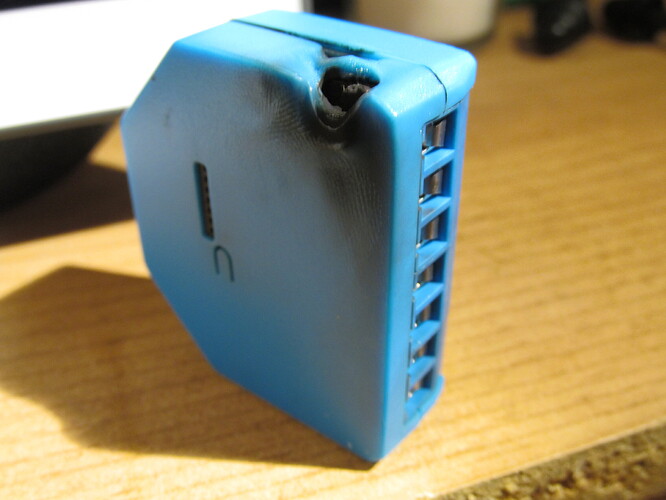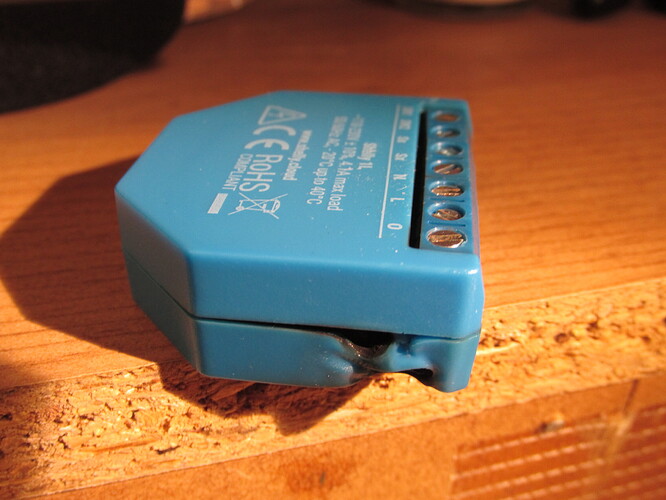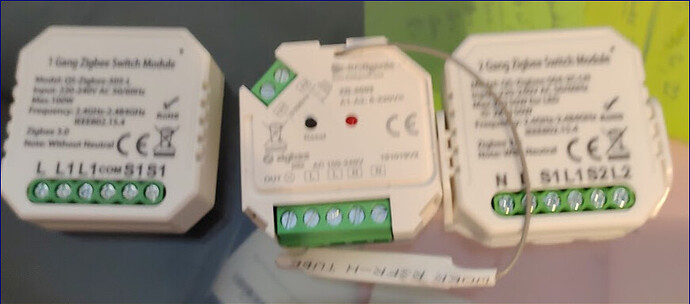Beware of shelly 1L its not safe. Burnt out in half an hour.
How much load did you put on it? The 1L is only rated for like 4A.

What @JasonJoel said ...... I've got four of these myself and they are all fine so far.
Given this is the third thread where you've posted these photos and claims, please provide more information on why you think they aren't safe!
16w 2D bulb. It grabs about 0.1A
I would be curious to see the insides of it to see what exactly burnt out in it, this has to be a manufacturing defect.
ill try to return it dont have high hopes to it cause i bought it from shellystore UK.
No email nor paper receipt either.... you can think
That is pretty shocking then. Thanks for the warning / sharing your experience.
I’ve never purchased any Shelly devices, but you bought it directly from the company and there’s no receipt of your purchase? Or perhaps I’ve misunderstood?
Well i didnt receive any confirmation email or receipt in the plastic bag.
Wow that sounds pretty disorganized, unless the email receipt was trapped by a spam filter or something.
I agree with others, you should really contact the manufacturer directly about this if you haven’t already.
Do you have a credit card statement (or other payment method) that documents the transaction at least? If the purchase was directly through their online store then maybe they’ll be able to find it in their system.
Its alright its not the money. Its only 15 quid. But i just wanted to let others know that this particular product is not safe. Im buying smart stuff for two years, loads of Chinese ones as well and never ever happened anything like this before. This is gross.
Agreed, while I do hope you get your money back, if you in fact purchased a defective product, it's more about providing information either to fellow users, or preferably the manufacturer of the device, to demonstrate that it's truly a manufacturing defect or something beyond user error or some other isolated cause. It's much less helpful to proclaim "not safe," in several different threads no less, with minimal detail provided, even after several requests for clarification.
The way you are presenting this looks a lot more like a campaign to kick Shelly around in the dirt more than helping. You posted in 3 different threads but you just don't seem like you want to get to the bottom of this.
Contact them and make them find the problem behind this and report back, if Shelly does not respond well and just don't care about having the part back for investigation, now that deserves having them kicked around in the dirt, but until you have proof that they have a cheap product and they don't car, it's just something that happens and could be a manufacturing defect or could also be an error in the documentation and it can't actually support fluorescent bulbs.
I'd like to ask the people here with a lot of electrical experience about a similar product.
(My apologies for the out of focus shot, but I'm sure you get the picture)
If I use this type of relay on a bank of 3-5 LED pot lights, surely I'm not going to draw more than a few amps, correct? These are usually rated for 10 amps, and some for 16 amps.
There should be no danger with these, correct?
You should read the maximum operational ratings of your switching devices (plus any other cables or electronics in the signal path).
Then read the maximum power draw specifications of your load(s).
Then make sure that everything in the signal path between your mains breaker and the load is rated equal to or higher than what the total load may draw.
Use a reference like this if you need to convert the ratings between current flow and power consumption: How to Calculate Amperage Draw | Sciencing
Wow. Some surprising responses.
I don't know @zsolt.toth.39 and don't use this device, but I'm quite surprised by the number of people who are criticizing him or her for this warning. Regardless of the cause, the photos clearly demonstrate this this was not a controlled failure (ie., the way a fuse would blow). The initial post was short and without excessive opinion, and @zsolt.toth.39 did respond to queries for more details about the load and purchase (not that he/she is obligated to respond to people here -- that's certainly info to provide to the vendor). I wouldn't characterize that as typical of someone who is out to "kick Shelly around in the dirt".
Sure, a product can have a defect -- including defective documentation. Whether the manufacturer "cares" or not, whether the manufacturer is responsive to their customer or not, there's value in warning other customers. Even if the manufacturer identified a defect and wanted to reach out to customers, a post here will probably get more attention from owners of the device.
The underlying fault may well have been user error -- I simply don't know (and neither does anyone who's rushing to defend the manufacturer). Even if it was user error, I hope that a well-designed piece of electrical gear would fail in a safer and more controlled manner.
I’m not sure if anyone is defending the manufacturer, more-so trying to clarify how the conclusion the OP made is justified? The initial details were scant, and questions still remain despite some being filled in.
Any electrical device that has failed is, technically speaking, not safe I suppose. But the implication of blame or that it’s a widespread problem from the get-go may or may not make sense.
It's more about the post title and claim with only a result to show. You need to know the cause before you can just state "not safe". That's all. No need to get upset about any of this.
I'll start by just adjusting the post title.
The real concern is all of those (hard to tell because it's blurry) seem to be CE only. That's a self-certification and doesn't mean anything compared to the ETL or UL independent certification houses.
Low quality components, traces built up with solder to help them carry a bigger load  , and potentially plastic that isn't fire-retardant are some of the issue I've seen. One of the Sonoff devices I bought was so poorly manufactured, I just abandoned it for fear of it causing a fire.
, and potentially plastic that isn't fire-retardant are some of the issue I've seen. One of the Sonoff devices I bought was so poorly manufactured, I just abandoned it for fear of it causing a fire.
A great point that appears to apply to this Shelly device as well. Always something to keep in mind when selecting a device that is hardwired.




